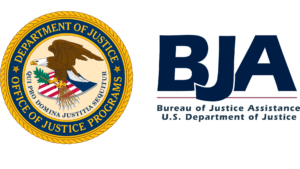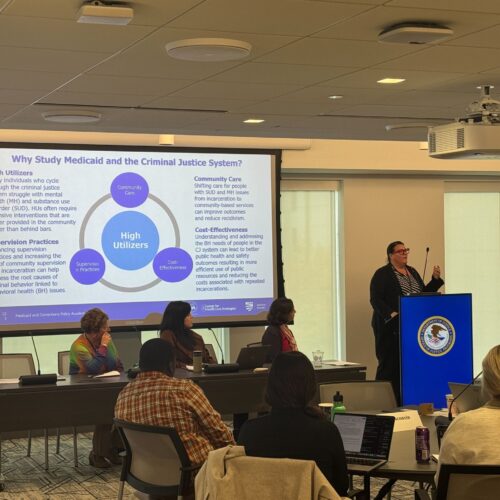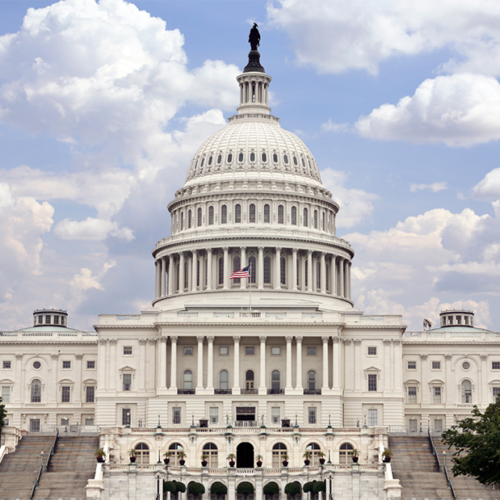Medicaid Basics for Correctional Leaders and Agencies
Over the last several years, changes to Medicaid policy enacted by Congress and a new Medicaid Section 1115 Reentry Demonstration opportunity offered by the Centers for Medicare & Medicaid Services provide new tools for state and local jurisdictions to consider for the provision of health care services to people under correctional care. With this resource, correctional leaders will gain a greater understanding of how Medicaid and the Children’s Health Insurance Program operate and of important terms like eligibility, benefits, services rendered, State Plan Amendments, and waivers. Additionally, this brief will discuss opportunities for alignment between state Medicaid and correctional partners to leverage resources to improve outcomes for people involved in the justice system and returning to their communities. Photo by Christina Morillo via Pexels
Introduction
Over the last several years, changes to Medicaid policy enacted by Congress and a new Medicaid Section 1115 Reentry Demonstration opportunity offered by the Centers for Medicare & Medicaid Services (CMS) provide new tools for state and local jurisdictions to consider for the provision of health care services to people under correctional care. With this resource, correctional leaders will gain a greater understanding of how Medicaid and the Children’s Health Insurance Program (CHIP) operate and of important terms like eligibility, benefits, services rendered, State Plan Amendments, and waivers. Additionally, this brief will discuss opportunities for alignment between state Medicaid and correctional partners to leverage resources to improve outcomes for people involved in the justice system and returning to their communities.
What Are Medicaid and CHIP?
Created alongside Medicare in 1965, Medicaid is a joint federal and state program providing free and low-cost health coverage to people with low income, families and children, pregnant women, the elderly, and people with disabilities, totaling approximately 74 million Americans.1 Medicaid eligibility is primarily based on income and disability status, serving a population that overlaps significantly with people involved in the justice system. While the federal government sets minimum standards for eligible populations and the types of services covered through Medicaid, states have flexibility in designing their Medicaid programs.
CHIP was created in 1997 to provide coverage to children whose parents’ income is above Medicaid eligibility levels, but too low to afford private coverage, totaling approximately 6 million children.2 Like Medicaid, CHIP has eligibility and benefits standards, is administered by states, and is jointly funded by states and the federal government.
Why Is Medicaid Important for Correctional Agencies?
- People who are incarcerated often have complex chronic conditions, and the period directly following release from prison or jail is a time of high risk for experiencing negative health outcomes.
- Studies have shown that Medicaid coverage and services can help ensure that there is a bridge for continuity of care from pre- to post-release, which contributes to reducing recidivism rates and improving health outcomes.
- The “inmate exclusion policy” has prohibited federally funded health insurance programs, including Medicaid, from financing care for people in correctional facilities (excluding hospitalizations of more than one day).
- Due to the “inmate exclusion policy,” state Medicaid and correctional systems have operated mostly independently, despite serving overlapping populations. This means there have not been as many opportunities in the past for correctional leaders to work with Medicaid, although some correctional leaders have had the opportunity to coordinate through statewide councils or to serve specialized populations.
- People who are incarcerated are the one group in the United States with a constitutional right to health care. Correctional facilities are required by the 1976 United States Supreme Court case of Estelle v. Gamble, which established that the Eighth Amendment’s prohibition of cruel and unusual punishment extends to the health care needs of the correctional population.
- Health care services constitute a significant proportion of state and local correctional budgets. A national survey of state prisons found that state departments of corrections spent a total of $8.1 billion on health care expenditures, which represents approximately one-fifth of overall expenditures.3
What Is the Medicaid Inmate Exclusion Policy?
In 1965, the Social Security Act created Medicaid as an insurance program to support access to health care for people with limited income. The Social Security Act (Sec.1905(a)(A)) prohibits the use of federal funds and services for medical care provided to “inmates of a public institution” (excluding hospitalizations of more than one day). The Social Security Act does not make a statutory distinction between a person who is convicted and a person incarcerated prior to conviction.
- The Affordable Care Act (ACA), passed in 2010, allowed states to expand Medicaid coverage to adults with income at or below 133 percent of the Federal Poverty Level (FPL), with 41 states (including the District of Columbia) opting for this expansion as of September 2024.
- This change resulted in a significant increase in the number of people who are involved in the justice system and who are eligible for Medicaid, with studies estimating that between 80 and 90 percent of state prison populations in expansion states are likely eligible for Medicaid.4
- This change also elevated the role of addressing social determinants of health, which can considerably impact physical and behavioral health outcomes particularly among correctional populations, and paying attention to factors such as health care access and quality for this population to assist in effecting systemic change.5
- As a result, facilitating enrollment in Medicaid and establishing connections to Medicaid providers upon release have become even more critical strategies for improving outcomes and reducing recidivism.
- Recent federal policy changes have also created pathways for states to provide Medicaid coverage for eligible individuals to access select services up to 90 days prior to release from correctional facilities.6 These changes present opportunities for partnerships between corrections and Medicaid agencies to improve reentry outcomes and advance shared priorities. For more information on these changes, see What Correctional Agencies Need to Know about the Medicaid Reentry Section 1115 Demonstration Opportunity.

Centers for Medicare & Medicaid Services, “Medicaid and Justice-Involved Populations: Strategies to Increase Coverage and Care Coordination,” (PowerPoint presentation, August 17, 2017), https://www.medicaid.gov/state-resource-center/downloads/mac-learning-collaboratives/justice-involved-populations.pdf.
Young People Covered under the Consolidated Appropriations Act (CAA) of 2023
New provisions for Medicaid coverage of eligible youth or young adults (young people) take effect January 1, 2025. Medicaid-eligible youth under age 21, CHIP-eligible youth under age 19, and former foster care youth up to age 26 who are eligible for Medicaid under the mandatory former foster care children group become eligible for Medicaid coverage within 30 days of their release from juvenile and adult correctional facilities.
Under Section 5121 of the CAA, states must provide the following services to eligible young people:
In the 30 days prior to release or within one week or as soon as practicable after release: Certain screenings and diagnostic services in accordance with state-determined standards and the Early and Periodic Screening, Diagnostic, and Treatment (EPSDT) requirements for Medicaid or the approved CHIP state plan, including behavioral health screenings or diagnostic services to eligible young people who are post-adjudication in public institutions.
In the 30 days prior to release and for at least 30 days following release: Targeted case management services designed to assist eligible young people with gaining access to needed medical, social, educational, and other services.7
In the 30 days prior to release: Case management services otherwise available under the approved CHIP state plan, including referrals to appropriate care and services in the geographic region of the home or residence for the eligible young person, where feasible.
How Are Medicaid and CHIP Financed?
Medicaid and CHIP are jointly financed by federal and state governments:
- The federal government pays a guaranteed percentage of all Medicaid costs. This percentage is determined by the federal medical assistance percentage (FMAP), which varies by state and cost category.
- State governments must finance at least 40 percent of their portion of overall Medicaid expenses from state general revenue. The remaining 60 percent may be financed through other public funding sources, such as contributions from county governments and health care-related taxes.
- Congress created enhanced matching rates for CHIP that are typically 15 percent higher than Medicaid rates to incentivize states to expand coverage for children.8
States can utilize managed care organizations (MCOs), Fee for Service (FFS), Prepaid Health Plan, and Accountable Care Organizations (ACOs) to administer Medicaid benefits. These delivery system models are contracted by state Medicaid agencies to coordinate health care services for Medicaid beneficiaries. These entities are typically paid a predetermined amount per Medicaid enrollee and are responsible for enrolling Medicaid beneficiaries in their insurance plans, coordinating care, and contracting with health care providers to deliver covered services.
Who Is Eligible?
Medicaid primarily serves individuals and families with low income. All states are required to provide Medicaid coverage to the following populations:9
- Individuals who are pregnant and children up to 19 years old: Medicaid provides coverage for pregnant individuals (up to 60 days post-partum) and children up to the age of 19 if their family’s income is below 138 percent of the FPL.10 47 states have expanded post-partum coverage to 12 months.11
- Families meeting Aid to Families with Dependent Children (AFDC) standards: Medicaid eligibility extends to families who would have been qualified through AFDC as of July 1996. This typically includes households with income levels up to 100 percent of the FPL.
- Individuals receiving Supplemental Security Income (SSI) and related programs: Individuals who already receive benefits from SSI are eligible for Medicaid. This typically includes individuals with disabilities with incomes near or below the FPL.
- Newborn children of Medicaid-eligible individuals: Newborn children born to individuals eligible for Medicaid automatically qualify for coverage.
- Transitional Medical Assistance: Some families whose income increases and may no longer qualify for regular Medicaid coverage can still receive assistance through Transitional Medical Assistance.
- Youth in foster care and formerly in foster care: Medicaid coverage extends to youth in foster care, and individuals who were previously in foster care can retain Medicaid coverage up to the age of 26.
CHIP eligibility12 includes young people who are: under the age of 19; uninsured (determined ineligible for Medicaid and not covered through a group health plan or creditable health insurance); a citizen of the United States or someone who meets immigration requirements; a resident of the state in which they’re applying for coverage; and eligible within the state’s CHIP income range, based on family income, and any other state-specified rules in the CHIP state plan.
States may also provide Medicaid coverage to the following optional populations:
- Adults without children, without disabilities, and with incomes up to 138 percent of the FPL: States that have chosen to expand Medicaid through the Affordable Care Act (“expansion states”) must cover this population. The federal government currently provides an enhanced FMAP of 90 percent to expansion states for individuals in this eligibility category.
- Individuals receiving home and community-based services (HCBS): States have the option to cover select HCBS through Medicaid, which are designed to help older adults and individuals with disabilities receive longterm care and support services in their homes or communities.
- Individuals deemed presumptively eligible for Medicaid: Certain individuals can be provisionally enrolled in Medicaid based on preliminary eligibility determinations made by health care providers. Some correctional institutions that are designated entities can support presumptive eligibility options for people leaving jails and prisons.
Criteria for presumptive eligibility determination could be based on the following information:
-
-
- Residency
- Citizenship
- Family size and composition
- Gross family income
- The individual’s pregnancy status
-
- Women with breast or cervical cancer: States have the option to cover women with breast or cervical cancer up to 250 percent of the FPL.
- Children with family income greater than 138 percent of the FPL: States may choose to extend coverage to children whose family income exceeds the eligibility threshold for mandatory coverage.
- People with medical needs: This group includes people whose incomes fall below the eligibility threshold once medical expenses are considered. States have the option to cover these individuals under Medicaid.
What Benefits Are Covered?13
State Medicaid programs are required to cover many health services, including:
- Some behavioral health services, including medication-assisted treatment (MAT)
- EPSDT for children
- Home health services
- Inpatient hospitalization
- Lab and imaging
- Nursing facility care
- Outpatient hospitalization
- Physician visits
- Transportation to medical care
States have the option to cover other health services, including:
- Case management
- Dental services
- Emergency hospital
- Home and community-based services
- Physical therapy
- Prescription drugs
- Prosthetic devices
- Vision and eyeglasses
How Do States Make Changes to Their Medicaid Program?
- Although CMS is responsible for Medicaid program administration at the federal level, each state Medicaid agency establishes its own policies and manages programming on a day-to-day basis. Federal law compels each state to select a single state agency to administer or supervise the administration of its Medicaid program. This agency often contracts with other public or private entities to execute program responsibilities.
- States have various pathways to exercise flexibility within their Medicaid programs, but as a state-federal partnership, states must have a clear agreement with the federal government about when and how federal Medicaid funds can be used. While some adjustments can be made through state legislative or regulatory channels, changes to Medicaid state plans require approval from the CMS. Two mechanisms for this flexibility, both requiring CMS approval, include:
- State Plan Amendment (SPA): States may propose State Plan Amendments to modify their Medicaid programs within existing federal regulations. For instance, a state might submit a SPA to initiate coverage for adult dental care services.
- Section 1115 Demonstrations: Also known as “1115 waivers,” Section 1115 demonstrations provide states with the flexibility to pilot new approaches that modify Medicaid eligibility, benefits, and delivery systems in ways not typically allowed under federal regulations. In recent years, states have used 1115 demonstrations to expand coverage for services addressing health-related social needs, such as nutrition support, and to offer pre-release services to people exiting jails or prisons.
How Can State Medicaid and Corrections Leaders Align Priorities?
Access to health care coverage, like Medicaid, enables people to address their physical and behavioral health needs through increased access to providers and services. This access not only supports overall health and wellbeing but also fosters stability, enhancing a person’s ability to secure employment and housing during reentry. Research indicates that Medicaid access is associated with lower rates of recidivism.14
Medicaid and corrections leaders are increasingly collaborating to improve outcomes for reentering populations, maximize state and federal resources, and reduce recidivism. Opportunities for collaboration and alignment include the following:
- Designing state Medicaid policies and programs to ensure timely access to Medicaid-covered services upon release from jails and prisons.
- Suspending, rather than terminating, Medicaid coverage during incarceration, which is a critical mechanism to expedite Medicaid enrollment following release from jails and prisons. This is a requirement through the Consolidated Appropriations Act of 2024 starting in 2026 for adults and youth.
- Partnering across agencies to assign dedicated enrollment staff to support people in the justice system with Medicaid enrollment and designate correctional facilities as qualified entities to make presumptive eligibility determinations, extending temporary Medicaid enrollment to people who may not have necessary paperwork at the time of reentry.15
- Developing Medicaid services intentionally tailored to serve people with prior justice system involvement. For example, states have provided financial incentives for primary care providers to offer care management and integrated primary and behavioral health care services to individuals with histories of justice involvement.
- Building relationships with community health centers or Federally Qualified Health Centers (FQHCs) to provide a seamless transition by scheduling appointments before release and bringing providers inside to provide pre-release services for individuals leaving incarceration who have significant health care needs.
- Leveraging the Medicaid Section 1115 Reentry Demonstration Opportunity.16 Under this demonstration, states can provide Medicaid reimbursement for key reentry services for Medicaid-eligible individuals up to 90 days prior to release from correctional settings. As of September 2024, CMS has approved 11 state waivers, and 13 states have pending waiver applications under this demonstration opportunity.17 States can also pursue 1115 demonstrations to provide Medicaid reimbursement for services that address health-related social needs, including housing navigation, case management, supported employment, and nutrition support. These services can be targeted towards people with justice system involvement to address risk factors for recidivism and other adverse outcomes.
- Implementing Medicaid reimbursement for health care services proven effective in diverting people from the criminal justice system, such as peer support services, mobile crisis response services, or community responder programs that respond to calls for service through 911, which connect people experiencing behavioral health crises with trained behavioral health providers.
Conclusion
Many people leaving jails and prisons are eligible for Medicaid. Evidence shows that Medicaid coverage is critical to reducing recidivism, improving public safety, and advancing health outcomes.18 More partnerships between Medicaid agencies and correctional agencies can be successful in increasing access to Medicaid for people returning home from incarceration. States are also utilizing Medicaid to advance broader reentry and behavioral health diversion goals. Explore these additional resources to learn more:
- What Correctional Agencies Need to Know about the Medicaid Section 1115 Reentry Demonstration Opportunity
- CMS State Medicaid Director Letter: Opportunities to Test Transition-Related Strategies to Support Community Reentry and Improve Care Transitions for Individuals Who Are Incarcerated
- CMS State Health Official Letter: Provision of Medicaid and CHIP Services to Incarcerated Youth
- Meeting the Moment: Opportunities to Improve Health and Safety by Changing Medicaid’s Role When People Are Incarcerated
This project was supported by Grant No. 15PBJA-23-GK-05504-MUMU awarded by the Bureau of Justice Assistance. The Bureau of Justice Assistance is a component of the Department of Justice’s Office of Justice Programs, which also includes the Bureau of Justice Statistics, the National Institute of Justice, the Office of Juvenile Justice and Delinquency Prevention, the Office for Victims of Crime, and the Office of Sex Offender Sentencing, Monitoring, Apprehending, Registering, and Tracking. Points of view or opinions in this document are those of the author and do not necessarily represent the official position or policies of the U.S. Department of Justice.



Endnotes
1. “Medicaid Enrollment and Unwinding Tracker,” The Kaiser Family Foundation, accessed April 28, 2024, https://www.kff.org/report-section/medicaid-enrollment-and-unwinding-tracker-overview/.
2. Centers for Medicare & Medicaid Services, April 2024 Medicaid and CHIP Enrollment Trends Snapshot (Maryland: Centers for Medicare and Medicaid Services, 2024).
3. The Pew Charitable Trusts, Prison Health Care Costs and Quality: How and Why States Strive for High-Performing Systems (Washington, DC: Pew Center on the States, The Pew Charitable Trusts, 2017), 14.
4. Carolyn Yocom, Medicaid: Information on Inmate Eligibility and Federal Costs for Allowable Services (Washington, DC: Government Accountability Office, September 5, 2014), https://www.gao.gov/assets/gao-14-752r.pdf.
5. Merrill Rotter and Michael Compton, “Criminal Legal Involvement: A Cause and Consequence of Social Determinants of Health,” Psychiatric Services 73, no. 1 (January 1, 2022): 108–11, https://psychiatryonline.org/doi/epdf/10.1176/appi.ps.202000741.
6. Centers for Medicare & Medicaid Services (CMS), State Medicaid Director Letter #23-003, Opportunities to Test Transition-Related Strategies to Support Community Reentry and Improve Care Transitions for Individuals Who Are Incarcerated (Baltimore: U.S. Department of Health and Human Services, April 17, 2023).
7. “Medicaid Definition of Covered Case Management Services Clarified,” Centers for Medicare & Medicaid Services, accessed August 16, 2024, https://www.cms.gov/newsroom/fact-sheets/medicaid-definition-covered-case-management-services-clarified.
8. “Financing,” Medicaid.gov, accessed July 15, 2024, https://www.medicaid.gov/chip/eligibility/index.html.
9. “Medicaid Eligibility,” Medicaid.gov, accessed April 28, 2024, https://www.medicaid.gov/medicaid/eligibility/index.html.
10. This coverage may be applied to pregnant individuals in Medicaid and CHIP and/or to children up to age 19 for CHIP or up to age 21 for Medicaid who would otherwise be eligible for coverage through these programs.
11. “Medicaid Postpartum Coverage Tracker,” KFF, August 1, 2024, https://www.kff.org/medicaid/issue-brief/medicaid-postpartum-coverage-extension-tracker/.
12. “Chip Eligibility,” Medicaid.gov, accessed July 15, 2024, https://www.medicaid.gov/chip/eligibility/index.html.
13. “Mandatory & Optional Medicaid Benefits,” Medicaid.gov, accessed October 10, 2024, https://www.medicaid.gov/medicaid/benefits/mandatory-optional-medicaid-benefits/index.html.
14. Gultekin Gollu and Mariyana Zapryanova, “The Effect of Medicaid on Recidivism from Medicaid Suspension and Termination
Policies,” Southern Economic Journal 89, (2022): https://onlinelibrary.wiley.com/doi/10.1002/soej.12600; Carrie E. Fry, Thomas G. McGuire,
and Richard G. Frank, “Medicaid Expansion’s Spillover to the Criminal Justice System: Evidence from Six Urban Counties,” The Russell
Sage Foundation Journal of the Social Sciences 6, no. 2, (2020): https://www.jstor.org/stable/10.7758/rsf.2020.6.2.11?seq=2; Samuel
Arenberg, Seth Neller, and Sam Stripling, “The Impact of Youth Medicaid Eligibility on Adult Incarceration,” American Economic Journal:
Applied Economics 16, no. 1, (2024): https://www.aeaweb.org/articles?id=10.1257/app.20200785&from=f; Shawn Fremstad, Clara Wilson,
and Anais Goubert, “Young Men Need More Medicaid,” The Center for Economic and Policy Research, September 29, 2021,
https://cepr.net/young-men-need-more-medicaid/.
15. Medicaid and CHIP Payment Access Commission, Access to Medicaid Coverage and Care for Adults Leaving Incarceration
(Washington, DC: Medicaid and CHIP Payment Access Commission, June 2023), https://www.macpac.gov/publication/accessto-medicaid-coverage-and-care-for-adults-leaving-incarceration-2/; TASC’s Center for Health and Justice, Presumptive Eligibility for Individuals Involved in the Justice Center System (Chicago: TASC’s Center for Health and Justice, October 2016), https://www.centerforhealthandjustice.org/tascblog/Images/documents/Publications/MedicaidPolicySeries-PresumptiveEligibility.pdf.
16. CMS, State Medicaid Director Letter #23-003.
17. Heather Saunders, “A Look at State Take-Up of ARPA Mobile Crisis Services in Medicaid,” The Kaiser Family Foundation,
November 30, 2023, https://www.kff.org/medicaid/issue-brief/a-look-at-state-take-up-of-arpa-mobile-crisis-services-in-medicaid/.
18. Jesse Jannetta et al., Strategies for Connecting Justice-Involved Populations to Health Coverage and Care (Urban Institute Health Policy Center and Justice Policy Center, 2018).
Project Credits
Writing: Andrew Spencer, Center for Health Care Strategies; Tiffany McKnight, CSG Justice Center
Research: Andrew Spencer, Center for Health Care Strategies; Tiffany McKnight, CSG Justice Center
Advising: Sarah Wurzburg, CSG Justice Center
Editing: Alice Oh, CSG Justice Center
Design: Michael Bierman
Web Development: Yewande Ojo, CSG Justice Center
Public Affairs: Jen Wilburne, CSG Justice Center

When returning to their communities from criminal justice settings, people with behavioral health needs face barriers in accessing…
Read MoreNew Hampshire Department of Corrections Commissioner Helen Hanks presents at the Medicaid and Corrections Policy Academy in-person meeting.
Read MoreThe Council of State Governments (CSG) Justice Center has launched the Collaborating for Youth and Public Safety Initiative…
Read More Assigned to the Cloud Crew: The National Incarceration Association’s Hybrid Case Management for People with Behavioral Health Needs
Assigned to the Cloud Crew: The National Incarceration Association’s Hybrid Case Management for People with Behavioral Health Needs
When returning to their communities from criminal justice settings, people with behavioral…
Read More Meet the Medicaid and Corrections Policy Academy Mentor States
Meet the Medicaid and Corrections Policy Academy Mentor States
New Hampshire Department of Corrections Commissioner Helen Hanks presents at the Medicaid…
Read More Six States Commit to Improving Statewide Strategies to Address Youth Crime, Violence and Behavioral Health
Six States Commit to Improving Statewide Strategies to Address Youth Crime, Violence and Behavioral Health
The Council of State Governments (CSG) Justice Center has launched the Collaborating…
Read More Bipartisan Group of 88 Lawmakers Push for Continued Funding for Reentry and Recidivism Programs
Bipartisan Group of 88 Lawmakers Push for Continued Funding for Reentry and Recidivism Programs
A bipartisan group of 88 lawmakers, led by Representatives Carol Miller (R-WV)…
Read More










